The Great Ball At Satan's
An oval-framed picture of a black poodle
The poodle appears often in this chapter, and the attentive reader knows why: in Faust by Johann Wolfgang von Goethe (1749-1832) the devil Mephistopheles appears to Faust as a poodle.
Margarita saw herself in a tropical forest
On April 23, 1935, Elena Sergeevna Shilovskaya (1893-1970), Bulgakov's spouse, described in her diary a reception, which she calls a ball. The reception was held at the Spaso House, the residence of the American ambassador in Moscow.
«I have never seen such ball in my life. They were all carrying tail coats, there were only a few jackets and smokings.
They danced in a room with columns lit by streams of light coming from a gallery; behind a gate which separated them from the orchestra, there were living pheasants and other birds. We had dinner at small tables in a huge dining room with, in a corner, living baby bears, goats and roosters in cages. During dinner, musicians played the accordeon.
In the room where we had dinner, the table where we were sitting was covered with a green transparant cloth lit from inside. There were armfuls of tulips and roses. I do not mention the abundance of food and champagne. On the upper floor (it is a big and luxurious mansion) they had arranged a room with a grillroom for shashlik and people were doing Caucasian dances.
We wanted to leave the place at half past three but they did not allow us to leave. We left at half past five in one of the cars of the embassy. A certain Steiger, I believe, a man whom we do not know but whom all Moscow knows and who can always be found when there are foreigners, joined us in the car. He was sitting next to the driver and we were in the rear. It was already daylight when we arrived home».
The tulips are also mentioned in this chapter, like many other eccentric details characterizing the parties of the American ambassador William Bullitt (1891-1967). Those parties were described in a colourful way by Charles Thayer (1910-1969), one of the embassy’s officials, in his book Bears in the Caviar (1951). The man Steiger, mentioned by Elena Sergeyevna, was Boris Sergeevich Steiger (1892-1937), the «stool pigeon» who was the prototype for Baron Meigel in the novel.
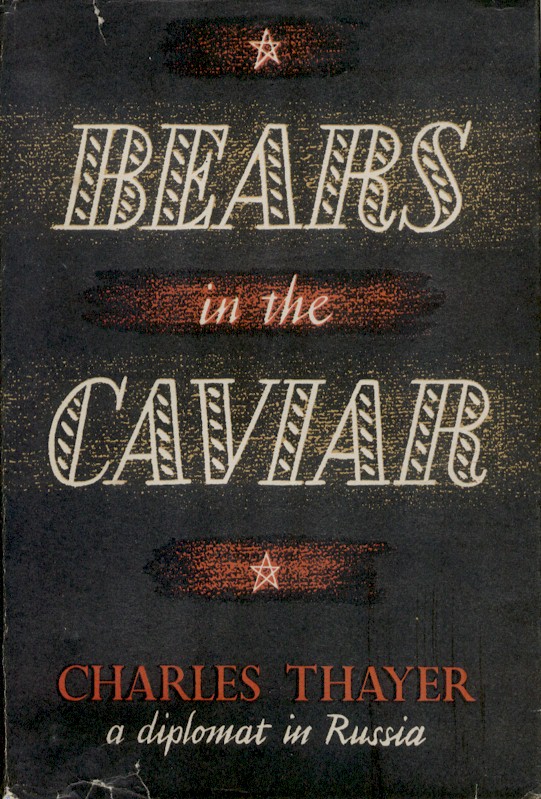
Bears in the Caviar by Charles Thayer
On this website you can download the text of the chapters of Bears in the Caviar describing the balls of William Bullitt at the Spaso House.
In the Locations section of our website, you can read a full description of the Spaso House by clicking the arrow below.
Hallelujah
Again - for the third time in the novel - Hallelujah by Vincent Youmans (1898-1946) is played. We saw it before in Griboedov (Chapter 5) and at doctor Kuzmin’s house (Chapter 18).
You can read more about the charleston Hallelujah in the section Themes, style and form of the Master & Margarita website by clicking the arrow below.
An absolutely enormous fireplace
In my country we put our shoe next to the chimney on the eve of December 6 for the arrival of Santa Claus. It's not the US-import Father Christmas, but the catholic Saint Nicolas (280-342), the former bishop of Myra, Turkey, and still the Catholic patron saint of the children.
In Russia, the chimney was an important ritual place as the path to another world. It was both the entrance and the exit for supernatural beings including devils and witches like in Christmas Eve written by Nicolas Vassilyevich Gogol (1809-1852). The soul disappeared through the chimney-pot after death. In the novel’s 1936 version, Margarita enters Berlioz’ appartment through the chimney too.
Tailcoaters... and naked women with them
«The men in tailcoat and the women naked» - this was apparently the dresscode at Satan's ball. The invitation which the Bulgakov’s got for the reception at the American embassy in 1935 had a handwritten note joined to it with the text «Tailcoat or black suit». It is quite unlikely that any of the women were naked at that reception.
A tailcoat or black suit are also part of the dress code in the Freemasonry. The interest of Bulgakov for Freemasonry can be explained by the fact that, in 1903, Afanasy Ivanovich Bulgakov (1859-1907), theologian and church historian, and the father of Mikhail Afanasievich, had written an article about Modern Freemasonry in its Relationship with the Church and the State, which was published in the Acts of the Theological Academy of Kyiv. Bulgakov refers more than once to Freemasonry in the novel.
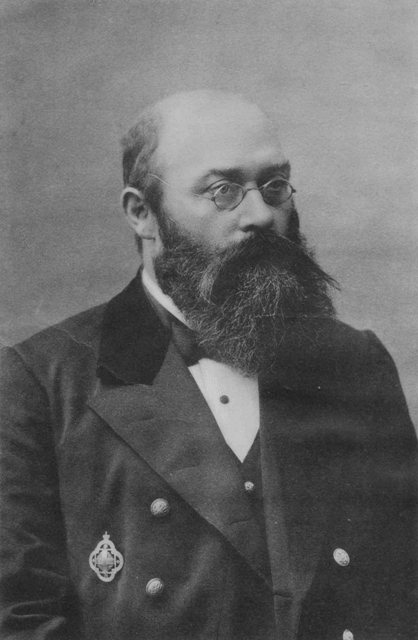
Afanasy Ivanovich Bulgakov
You can read more on Freemasonry in The Master and Margarita in the Context section of this website. by clicking the arrow below.
The guests at the ball
All guests at Satan's ball have some common characteristics. They're all dead, of course, and with the exception of the musicians, they all did something which made them go to hell - or which could have made them go to hell. The advantage of them being dead was that Bulgakov did not have to disguise their names.
Johann Strauss
The «waltz king» is the Viennese composer Johann Strauss jr. (1825-1899). His father, Johann Strauss sr. (1804-1849), was quite famous himself as the composer of the Radetzky Marsch. But his son Johann or Schani would rapidly become more famous with unforgettable waltzes as An der schönen blauen Donau, the Kaiserwalzer and Wiener Blut, and with the operettes Die Fledermaus and Der Zigeunerbaron. In the era of Johann Strauss jr. the Viennese Waltz was not played in theatres or concert halls like it happens today, but mainly in dance halls, at receptions or at other mundane events.

Johann Strauss jr.
Henri Vieuxtemps
Vieuxtemps is Henri Vieuxtemps (1820-1881), a Belgian virtuoso violinist from Verviers. At the age of ten he made his debut in Paris, where he was introduced by a virtuoso violinist of my hometown Leuven, Charles Auguste de Bériot (1802-1870). He travelled the world giving concerts, taught in the conservatory of Brussels and for some time, from 1846 to 1851, also in the conservatory of Saint-Petersburg, where he was first violinist of the imperial court and first soloist of the Royal Theatre. He was very successful with his own compositions too, among which 7 concertos, chambre music and compositions for violin and piano. It was common practice to hire musicians from all over the world to play at important receptions like the ones at the Spaso House.
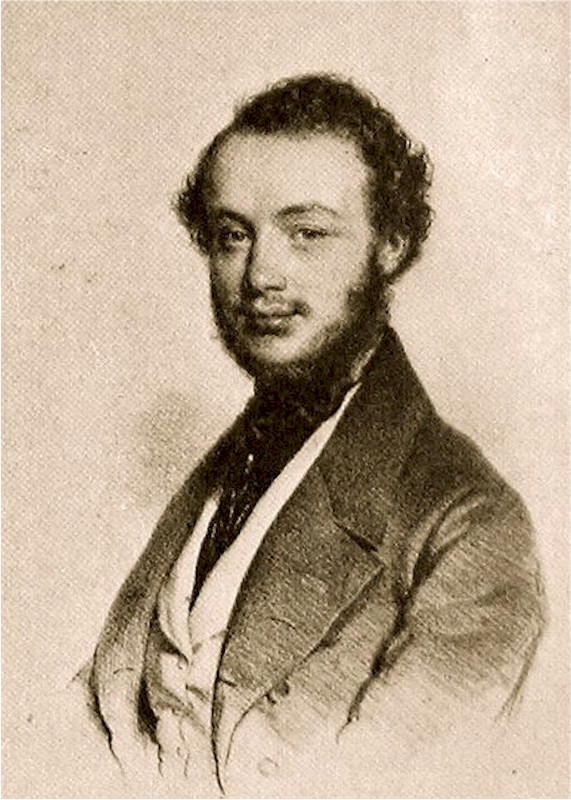
Henri Vieuxtemps
Kissing her knee
The incoming guests are greeting Margarita by kissing her knee. Some see this as a reference to Freemasonry, since the candidates should bare their right knees when being initiated as apprentices. And indeed, the guests at the ball are kissing Margarita's right knee.
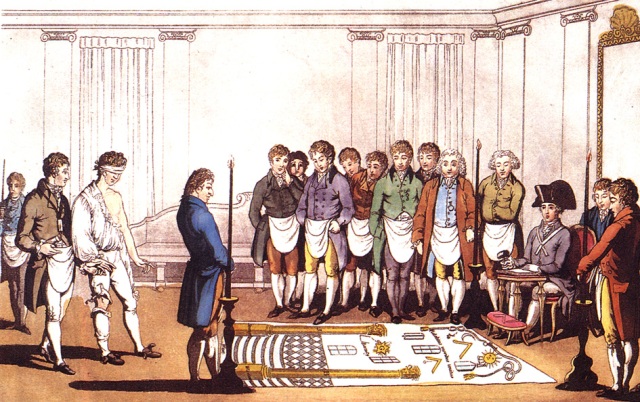
Initiation of a Freemason
Monsieur Jacques
Monsieur Jacques is Jacques Cœur (1395-1456), a rich French merchant who became superintendent of finances under Charles VII (1403-1461). He granted important loans to the king to finance his wars. The start of his career wasn't very lucky because, before he became successful, he was associated with a counterfeiter. And later he was accused of an attempt to poison Agnes Sorel (1422-1450), the king's mistress.
He was condemned to death, which later was changed into a lifelong banishment and a money fine. His properties were confiscated so that the king did not have to refund his loan. Later Louis XI would posthumously rehabilitate Jacques Coeur. In The Master and Margarita Korovyev called him a country traitor and an alchimist, but in fact he was not. He built a splendid castle in his native town Bourges.
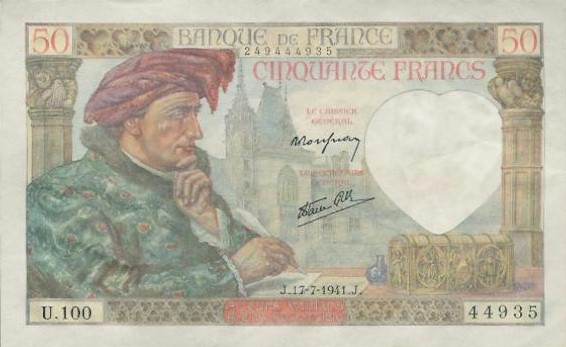
Monsieur Jacques
Earl Robert
Earl Robert, «a queen's lover» according to Korovyev, is Robert Dudley (1532-1588), count of Leicester and a childhood friend of the British queen Elisabeth I (1533-1603). He was the fifth of thirteen children. His spouse, Amy Robsart (1534-1560), died in mysterious circumstances but not, as suggested by Bulgakov, due to poisoning. In reality it was after falling down a flight of stairs.
Many rumours were going on about a liaison between Dudley and the queen. Many believed that Dudley had killed his wife to marry Elisabeth. Ironically enough, Amy's dead made a marriage impossible because Elisabeth was strongly influenced by the public opinion. She placed Count Robert in command of the army - he had to defeat the Spanish Armada - but he died soon after.

Earl Robert
Signora Tofana
In the Энциклопедический словарь Брокгауза и Ефрона [Entsiklopedichesky slovar Brokgauza i Yefrona] or Brockhaus and Efron Encyclopedic Dictionary, Bulgakov found the name of Signora Tofana or Teofania di Adamo (1653-?) under the lemma Аква Тофана [Akva Tophana]. She was one of a «dynasty» of poisoners from the 17th century. The poison having her name, aqua tofana, probably contained arsenic and deadly nightshade, also called belladonna, which is one of the most toxic plants found in the Western hemisphere. Children have been poisoned by eating as few as three berries. Aqua tofana is a colourless and tasteless liquid, therefore an ideal mean to kill spouses or family members.
We don't know much of the first Tofana, Teofania di Palermo, except that she got executed for various poison murders.
The second Tofana, Teofania di Adamo (1653-?), was from Naples, and would have got the recipe from the first Tofana. She would have been driven by manhate and would have sold the poison in bottles with the portrait of Saint-Nicolas, hence the tradename Manna di San Nicola. Her poison would have killed at least 600 people. She was tortured in public and executed.
The third Tofana, Giulia Tofana, operated in Rome and would have been the sister or the daughter of the second. She would have been sentenced to death, and executed at the Campo di Fiore.
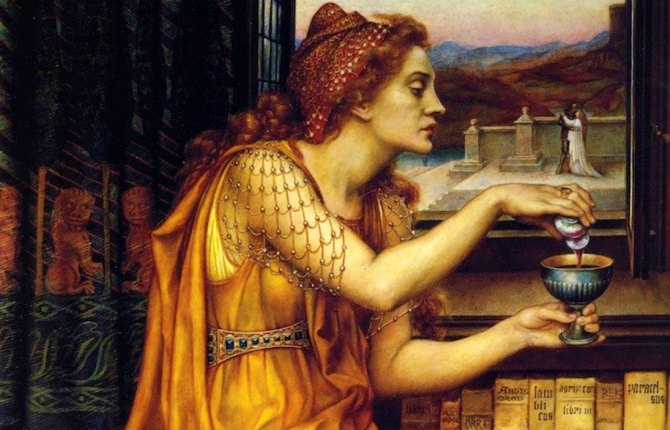
The Love Potion by Evelyn De Morgan
A Spanish boot
A Spanish boot is a wooden instrument of torture. It was some kind of mould which was put around the leg and constantly tightened. When a witch refused to confess, her legs were broken with this horrible tool.
Doctor James Fian, a schoolmaster in Saltpans (Scotland) was a male witch who was under the suspicion of high treason against the king. He would eventually be burned 1591 in Edinburgh. He described how he was «put through the most violent and the most cruel pain in the world, namely the Spanish boot», which made that «his legs were crushed and flattened, and the bones and the flesh were so bruised that the blood and the bone marrow splashed out of it in huge quantities».
Frieda
In Bulgakov's archives was found an excerpt from the book Die sexuelle Frage written by the Swiss neurologist and psychiatrist Auguste Forel (1848-1931). Forel got some conflicts with the Catholic church because he believed that the soul and the brains were connected inseparably.
Forel didn't just take care of his patients, he was also concerned about social reforms. He worked with alcoholics and an active member of the Swiss movement against alcohol abuse. He was a teetotallar himself. In Die sexuelle Frage he described the sexual problems he had observed in his practice. One of his study objects was a Fried Keller - who had killed a little boy, and a certain Koniecko - who had strangled a baby with a handkerchief.
Fried Keller worked in a café in the Swiss canton Sankt Gallen. The married owner of the place had a crush on her and when she was 19 years old he lured her into the cellar. In May 1899 she gave birth to a boy in the Sankt Gallen hospital. Her child was placed in a relief center but had to go out of there after 5 years. Forel described in detail her emotional state of mind during the period preceding Easter Monday 1904, when she would see her child again. But she heard that the nuns of the relief center had decided to send her child to her sister in Zürich. She took her child with her and brought it to the wood. She digged a grave with her hands, strangled the child with a piece of lace and went back home. But the child was found by gypsies after a heavy shower of rain, and Fried Keller was arrested on July 14.
Koniecko was a 19 years old worker from Silesia. She got pregnant in a similar situation, and strangled her newly born child with a handkerchief on February 25, 1908. She was sentenced to 2 years in jail. This court order was heavily criticized in Switzerland because the real guilty - the father of the child who abandonned her - was not punished.
Bulgakov combined the biographies of both women in the character Frieda, which may be a reference to the Faust of Johann Wolfgang von Goethe (1749-1832), in which Gretchen also kills her newly-born child.

Auguste Forel
The marquise
The marquise is Marie-Madeleine Dreux d'Aubray (1630-1676), marquise de Brinvilliers, a notorious poisoner who, with the help of her lover, army captain Jean Baptiste Godin de Sainte-Croix (?-1672), killed her father, her brother and her two sisters in order to get their inheritances. She would have used the notorious aqua tofana for it. There are rumours that she also killed poor people whom she frequently visited at hospitals. She was condemned to the trial by water, which is the forced drinking of sixteen pints of water, followed by decapitation and cremation.
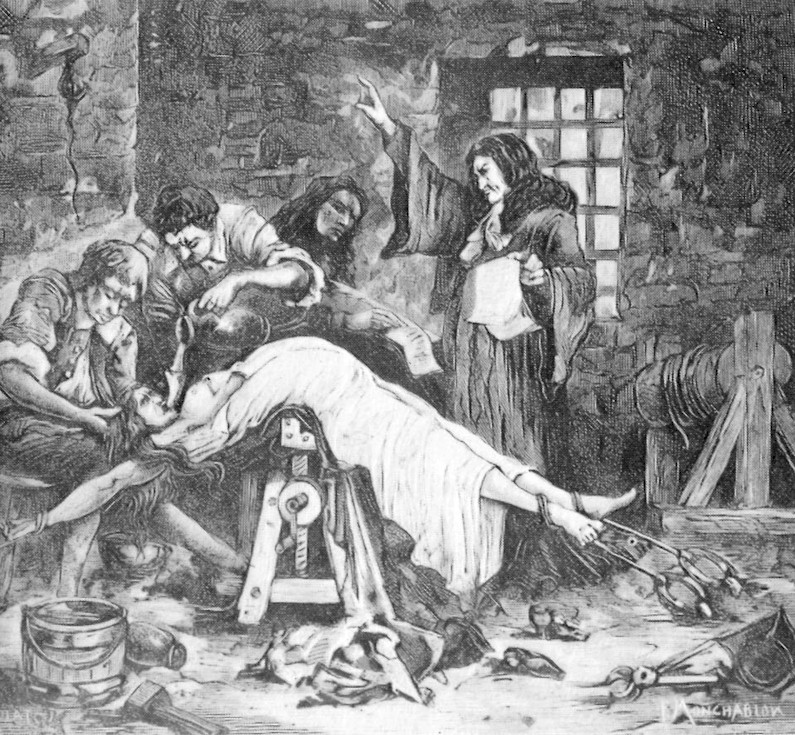
Marquise de Brinvilliers undergoing the trial by water
Madam Minkin
Madame Minkin, or in full Anastasiya Fyodorovna Minkina (1782-1825), was the housekeeper and lover of Count Aleksey Araksheyev (1769-1854), military advisor of czar Alexander I (1777-1825). She was an extraordinarily cruel and pernicious woman - one day she burned, blinded by jealousy, the face of a maid with curling tongs. Her own personnel revolted against her and killed her in 1825. Aleksey Araksheyev himself had little to learn from his mistress. The woman farmers on his country Gruzino near Novgorod were obliged to give birth to at least one child per year, and because he was font of the singing of the nightingales he let hang all the cats on his territory.
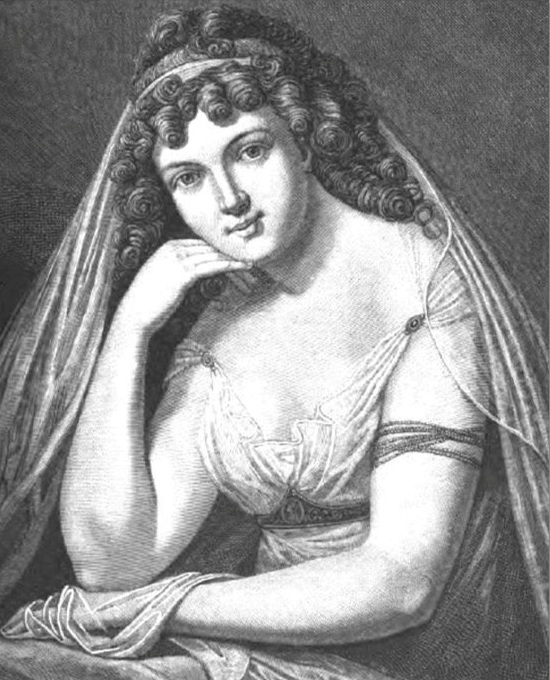
Anastasiya Fyodorovna Minkina
The emperor Rudolf
Emperor Rudolf or Rudolf II of Habsburg (1552-1612), German emperor and son of Maximilian II (1527-1576), lived in Prague and was the patron of Tycho Brahe (1546-1601) and Johann Kepler (1571-1630). In 1572 Brahe discovered a new star in the Cassiopeia constellation. He described this event in his book The Stella Nova. Later he became famous because it appeared to be a supernova. It proved that the atmosphere of the stars as it was described by Aristotle (384 BC-322 BC) wasn't constant. Johann Kepler was an assistant of Tycho Brahe. He became known for his elaboration of the laws of the movements of planets. Later, Isaac Newton (1643-1727) would use his discoveries for the development of his gravity law.
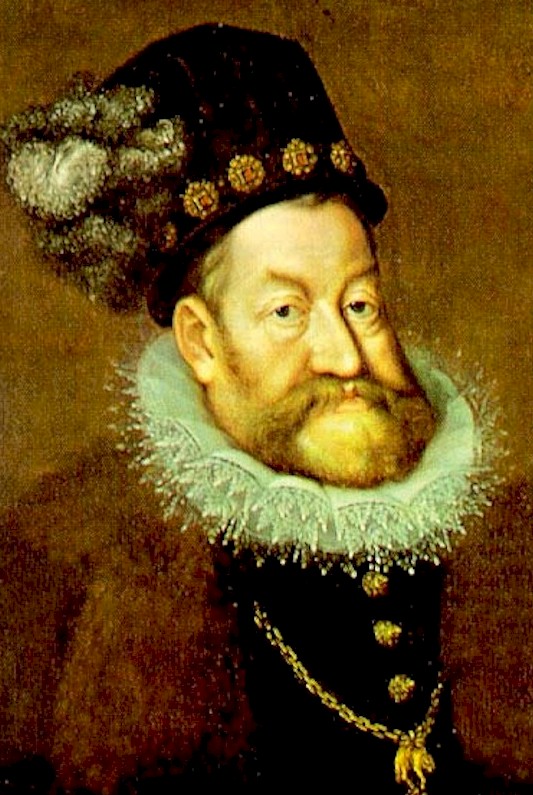
Rudolf II of Habsburg
The Moscow dressmaker
The Moscow dressmaker is Zoya Denisovna Pelts, the heroin of Bulgakov's own theatre play Zoya's apartment. Zoya managed a brothel under the guise of a dressmaker's shop. Her girls were so-called models and she was obsessed by the wish to change the Soviet Union for Paris.
Various prototypes are named for the figure of Zoya. The first might have been one Adèle Adolfovna Trostyanskaya who really had a brothel disguised as a boutique. Bulgakov had read an article on her trial in the newspaper Krasnaya Gazeta in October 1924. Later, there would also have been an article in the same newspaper about a certain Zoya Buyalskaya who was arrested because she had a brothel disguised as a sewing workshop. Finally, there is Zoya Petrovna Zhatova, who was arrested in the spring of 1921 in Moscow because she held a clandestine restaurant. Among the clients who were arrested together with her were the poets Anatoly Borisovich Marienhof (1897-1962) and Sergey Alexandrovich Yesenin (1895-1925), the husband of the American dancer Isadora Duncan (1877-1927).
Zoya Zhatova ran her business in apartment no. 38 of Bolshaya Sadovaya no. 10 where she has been staying for a while. That apartment belonged to the Armenian-Russian avant-garde artist Georgy Bogdanovich Yakulov (1884-1928). For the description of the physical characteristics of his Zoya, Bulgakov had been inspired the wife of Yakulov, Natalya Yulevna Shiff (1889-1974).
Caligula
Caligula is the nickname of Gaius Caesar (12BC-41). He was the youngest son of Germanicus (15BC-19) and Agrippina Senior (14BC-33), and he succeeded Tiberius (42BC-37) as the emperor of Rome. People called him mentally ill, because he put Rome through many tyrannical brutalities and got eventually killed. Caligula was raised in a military camp. He was popular among the soldiers and there he got his nickname Caligula, from the Latin caligae (soldier's boots). In his own time nobody used this nickname, it got only popular because historians used it all the time.
Messalina
Messalina, in full Valeria Messalina (15BC-48) was the third wife of the Roman emperor Claudius (10BC-54), the successor of Caligula. She was the daughter of Domitia Longina (10BC-54) and Valerius Messalla Barbatus (11BC-21). She was from a respectable Roman family, but she was known for her immorality. Once she would have challanged a notorious Roman prostitute, Scylla, to a sex competition. Scylla gave up after 25 men, but Messalina persisted until daybreak. Eventually she was executed because Claudius heard that she had organised a conspiracy against him. Later her daughter Claudia Octavia (39-62) would become the first wife of emperor Nero (37-68).
Maliuta Skuratov
Maliuta Skuratov with his «truly fiery beard» is the nickname of the Russian nobleman and notorious historical character Grigory Lukyanovich Skuratov-Belsky (?-1573), the right-hand man of Иван Грозный [Ivan Grozny] or Ivan the Terrible (1530-1584), the first Russian czar. Czar Ivan had proclamed so-called опричнина [oprichina], a state policy including the institution of a secret police. Skuratov was in command of the oprichniks, a special corps that terrorized the country with fire-raisings, plunderings and murders. With his own hands he strangled the Orthodox archbishop Philip II (1507-1569).
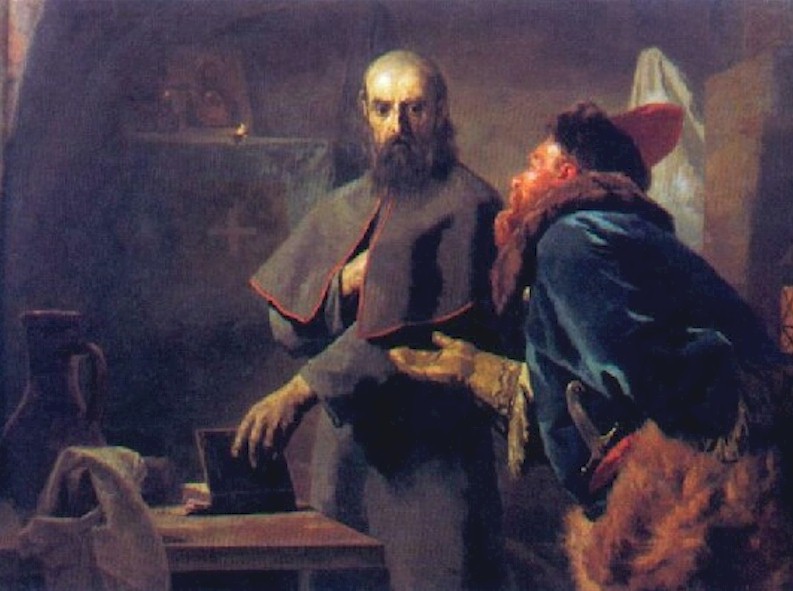
Maliuta Skuratov approaches Philip II
The last two guests
The last two guests are not explicitely named in the novel. But from the dialogue between Margarita and Koroviev we learn that the first one is the People's Commissar of Foreign Affairs and chief of the secret police NKVD Genrich Grigoryevitch Yagoda (1891-1938) and the second one is his secretary Pavel Pavlovich Bulanov (1895-1938). Both fell into disgrace and they were accused for having sprinkled the walls of the office of Nikolay Ivanovich Yezhov (1936-1938), Yagoda's successor, with poison. In 1938 they were sentenced to be shot during a show trial that got very famous, and for which they had been questioners themselves. Yagoda was a notorious gambler and womanizer.
Johann Wolfgang von Goethe and Charles Gounod
In the penultimate version of The Master and Margarita, Bulgakov wrote that Korviev introduced two other guests as the «last two», namely господин Гёте и господин Шарль Гуно [gospodin Gyete i gospodin Charles Guno] or mister Goethe and mister Charles Gounod.
These guests are, of course, Johann Wolfgang von Goethe (1749-1842) and Charles François Gounod (1818-1893), respectively the writer of the play and the composer of the opera Faust. They were the only two guests who bowed respectfully to Margarita but did not kiss her knee.
To each of them, Margarita presented a gift. She offered them each a small box with a gold laurel wreath «that can be worn as a badge of honour in a buttonhole». «Messire requests that you accept these wreaths in memory of the ball», she said. To the first one, she said this in German, to the other one in French.
Adolf Hitler and Joseph Stalin
Film director Yuri Kara (°1954) presents another opinion in his film Master i Margarita. He shows Adolf Hitler (1889-1945) and Joseph Stalin (1887-1953) making their appearance before Margarita. According to Kara, Bulgakov would have been thinking of them when he wrote: «The last two guests were coming up the stairs!». But he would not have named thise two dictators because, when the novel was written, they were still alive.
Spray the walls of the office with poison
The episode in which characters spray the walls of an office with poison is based on actual accusations that came to light in March 1938 in the trial of the so-called Anti-Soviet Block of Rights and Trotskyites, also called the Trial of the 21 including, among others, Nikolai Ivanovich Bukharin (1888-1938), Aleksei Ivanovch Rykov (1881-1938) and Henrich Grigoryevich Yagoda (1891-1938).
Yagoda had been removed as head of the secret service NKVD in 1936 and, supposedly fearing implication in the murders of Sergey Kirov (1886-1934) and writer Maksim Gorky (1868-1936), he had ordered his secretary Pavel Petrovich Bulanov (1865-1938) to spray the walls of the office of his successor Nikolai Ivanovich Yezhov (1895-1940) with poison. Yagoda and Bulanov were sentenced to be shot. Bulgakov understood all the farce of the fabricated charges, and Yagoda and Bulanov join the ranks of the imaginary poisoners at the ball.
Two hamadryads with manes like lions played grand pianos
Hamadryads are Greek mythological beings that live in trees. They are a specific species of dryads, which are a particular type of nymphs. Hamadryads are born bonded to a specific tree. If their tree died, the hamadryad associated with it died as well. For that reason, dryads and the gods punished any mortals who harmed trees.
The Kamarinsky
The word камаринская [kamarinskaya] is derived from the name of the city of Kamarino. It is a Russian dance song with a short, always repeated tune and quite coarse words. One version sounds as follows: «What an odd guy are you, peasant of Kamarino, how you stumble down the street. I run to the booze shop with a headache, because a peasant can’t live without booze» or: «Oh you son of a bitch, muzhik (peasant) from Kamarino…»
When on weddings the kamarinskaya is sung or danced, people don’t care much of the right steps. The grotesque steps, the twitching of the shoulders, the ugly and sometime disgusting movements - it’s all part of the game.
You can listen to an instrumental version of a kamarinskaya here:
In 1848, the Russian composer Mikhail Ivanovich Glinka (1804-1857) wrote the symphonic poem Kamarinskaya in which he introduced this popular Russian tune.
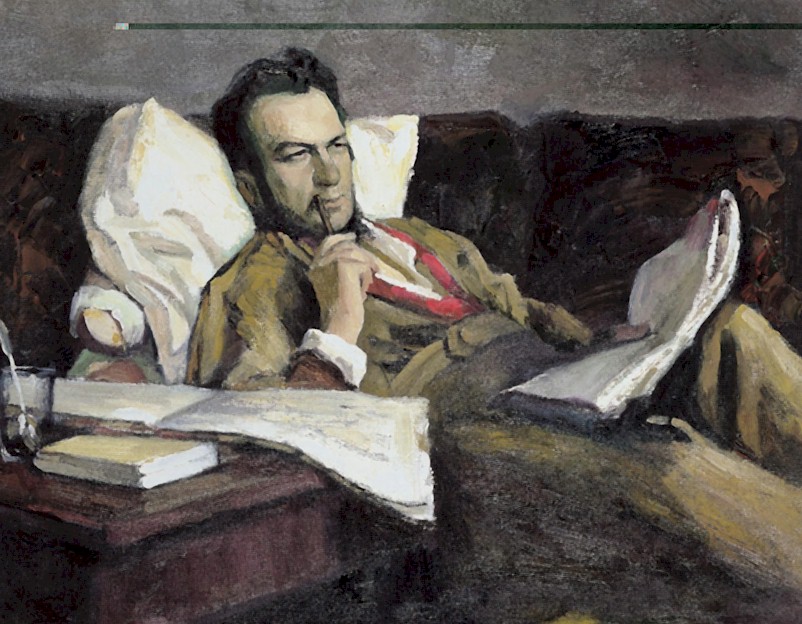
Mikhail Ivanovich Glinka
A salamander-conjurer who did not burn in the fireplace
At the ball Margarita sees a salamander-conjurer who did not burn in the fireplace. In medieval lore salamanders were thought to survive fires.
Another interesting connection is that the fireproof salamander was the symbol of the French king François I (1494-1547), who was the grandfather of Marguerite de Valois (1551-1615) and the brother of Margarita van Navarra (1492-1549).
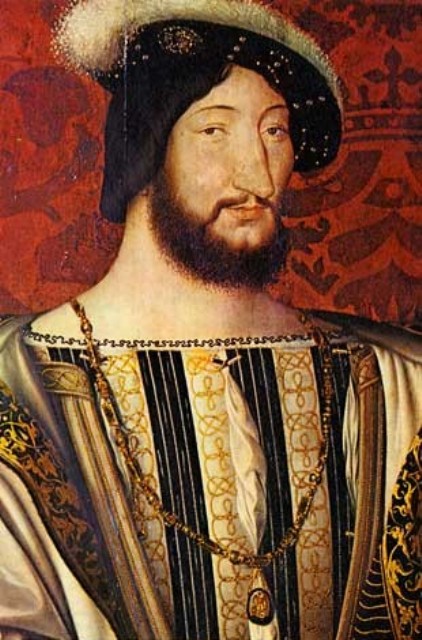
François I
His feet were in worn-out bedroom slippers
An apprentice who is initiated into the first degree of Freemasonry, must replace his right shoe by a slipper.
On this platter a man's severed head with the front teeth knocked out
Berlioz’ head on a platter recalls of course the biblical story of Salome who demanded to see the head of John the Baptist on a platter.

Salome with the head of John the Baptist
The skull being used as a cup recalls the story of the last pagan Russian prince of the land of Rus, Prince Svyatoslav I of Kyiv (942-972), the father of Prince Vladimir Svyatoslav le Great (956-1015) (see Chapter 18). The prince was caught in ambush and killed by the Pechenegs, nomad people from Turkish origin, when he wanted to cross the cataracts near Chortitsa in 972. The Primary Chronicle, a Russian manuscript from the 12th century describing the history of the land of Rus in a christian fashion, mentions that Kurya, the khan of the Pechenegs, made a chalice from his skull.
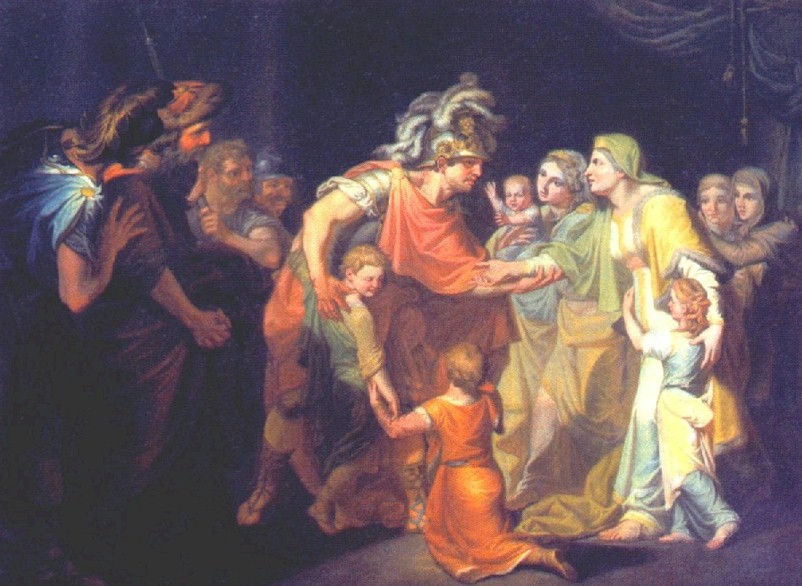
Prince Svyatoslav
It will be given to each according to his faith
The words of Woland: «It will be given to each according to his faith» are a rather free interpretation of Matthew 9:29: «According to your faith be it done unto you».
Baron Meigel
The real prototype for Baron Meigel's character is Baron Boris Sergeevich (von) Steiger (1892-1937). In the '20's and '30's he worked in Moscow at the Народный комиссариат просвещения (Наркомпрос) [Narodny kommisariat prosveshcheniya] (Narkompros) or People's Commissariat for Enlightening, where he was responsible for External Relations. Simultaneously he worked as an agent of the Объединённое государственное политическое управление (ОГПУ) [Obedinyonnoe gosudarstvennoe politicheskoye upravlenye] (OGPU) or the United State Political Administration, the secret service which became part of the notorious NKVD in 1934. In 1937, Steiger was arrested and executed.
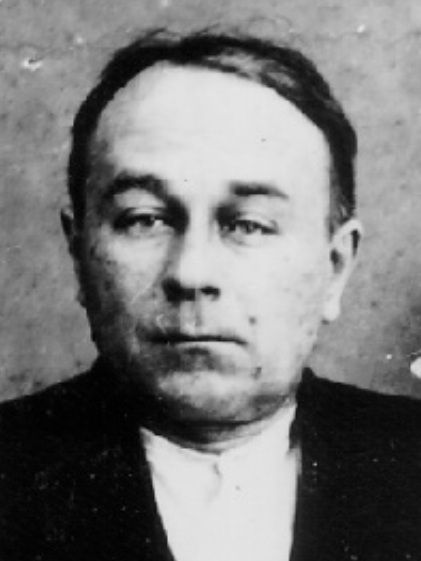
Boris Sergeevich (von) Steiger
Steiger is mentioned several times in the diary of Elena Sergeevna Shilovskaya (1893-1970). He was often found at the embassy of the United States. He reported on foreigners connected with the theatre, and on Soviet citizens having contact with the embassy.
In the Characters section of this website, you can read more on Boris Sergeevich Steiger by clicking the arrow below.
Some sort of black chlamys and a steel sword
At the end of the ball, when the skull of Berlioz was filled with the blood of Baron Meigel, Woland turned the skull to his lips, and a metamorphosis took place. The patched shirt and worn slippers which Woland first wore were gone. Now he was in some sort of black chlamys with a steel sword on his hip.
A chlamys was an ancient Greek type of rather short cloak, coming from Macedonia or Thessaly. It consisted of a rectangular piece of cloth, which was thrown over the left shoulder and was held together with a clothes pin on the right shoulder.
The black chlamys and the sword correspond to the gear of a Knight Kadosh or a Knight of the white and the black eagle, the 30th degree in the Ancient and Accepted Scottish Rite.
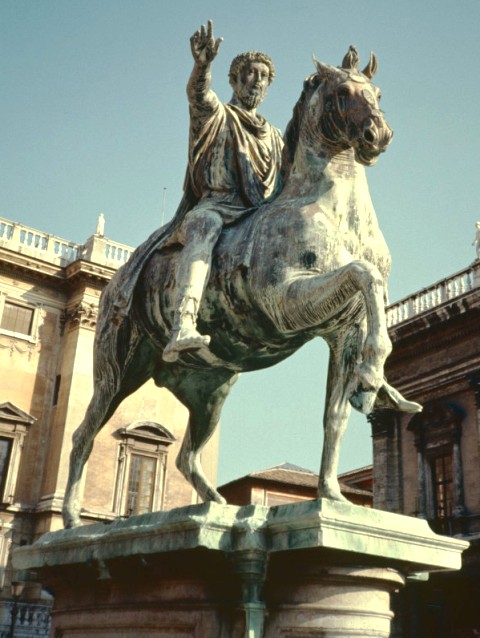
Marcus Aurelius dressed in a chlamys
Drink!
Woland touched the skull to his lips, but then he offered the cup to Margarita and ordered her to drink. That refers to the sealing of the brotherhood in Freemasonry by the mixing of the blood during the initiation to the degree of Entered Apprentice. The mixture is symbolically represented by a cup of red wine from which the venerable master and the candidate drink together.
Also in the ritual for the degree of Knight of the East and West, the 17th degree in the Ancient and Accepted Scottish Rite, the blood plays an important role. The Faithful Brother Master of Ceremonies leads the candidate to a basin where a lancet and some red wine are kept ready. He approaches the candidate, let some drops of wine fall on his arm while pretending leeching him. When the «blood» flows, it is collected on a cloth and shown to the candidate with the words: «One should never be afraid to shed his blood to set eyes on wondrous things»

All films based on The Master and Margarita have been subtitled by your webmaster in English, French, Dutch, German, Spanish and Italian. Click on the images below to find them.
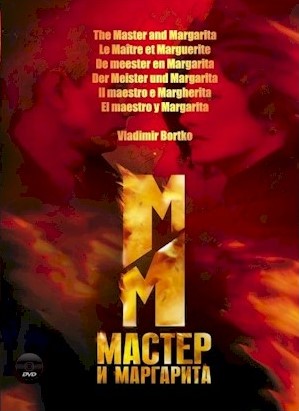 |
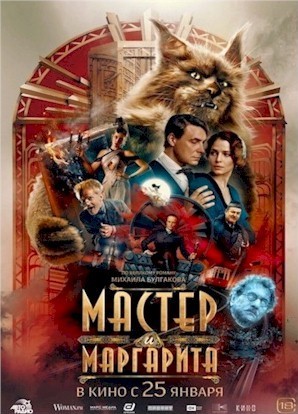 |
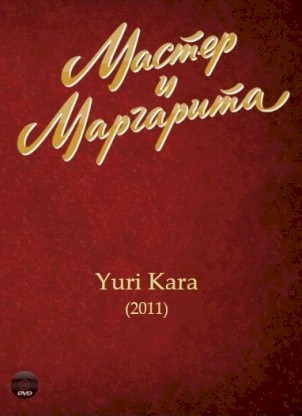 |
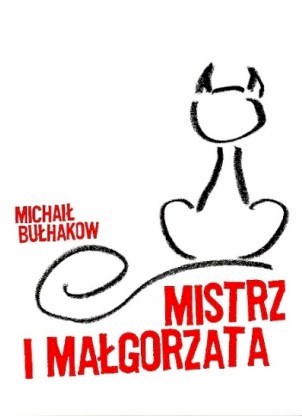 |
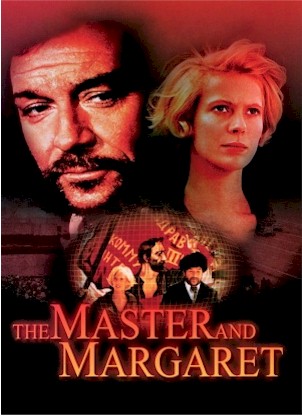 |
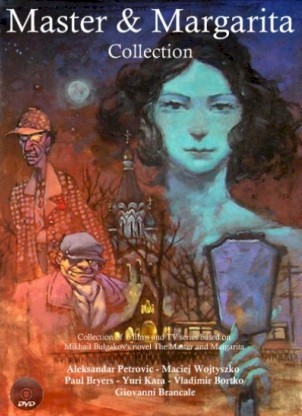 |






